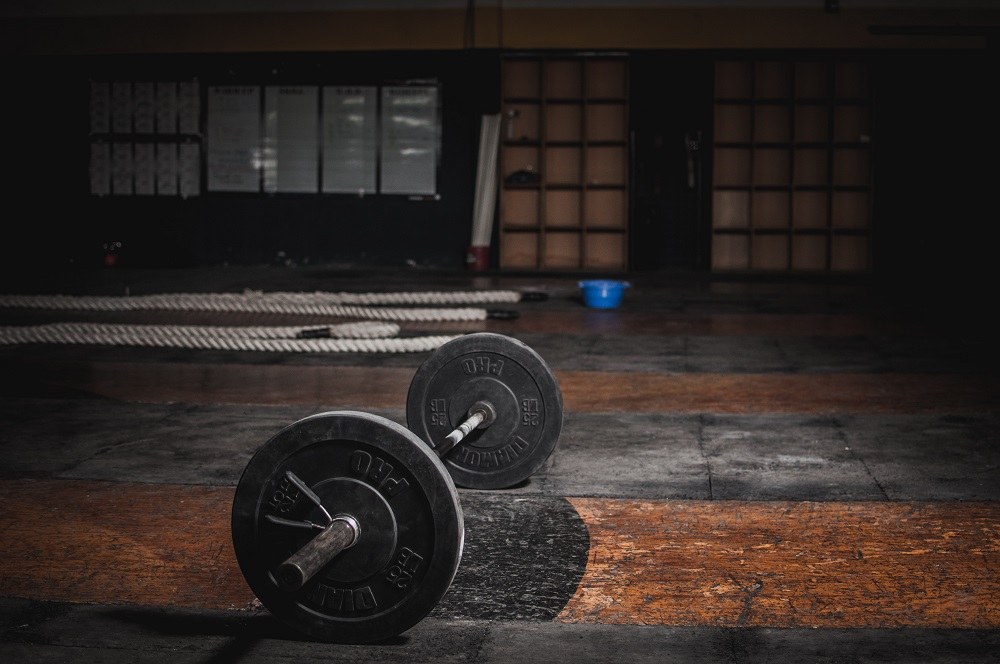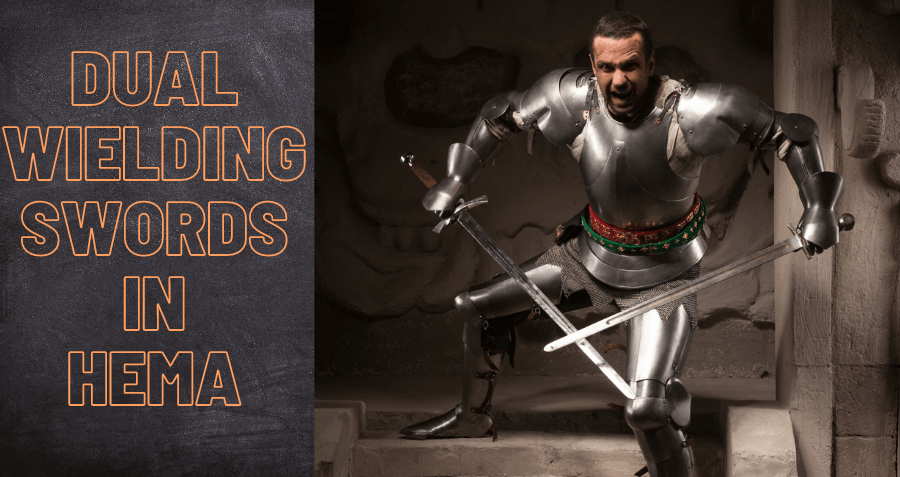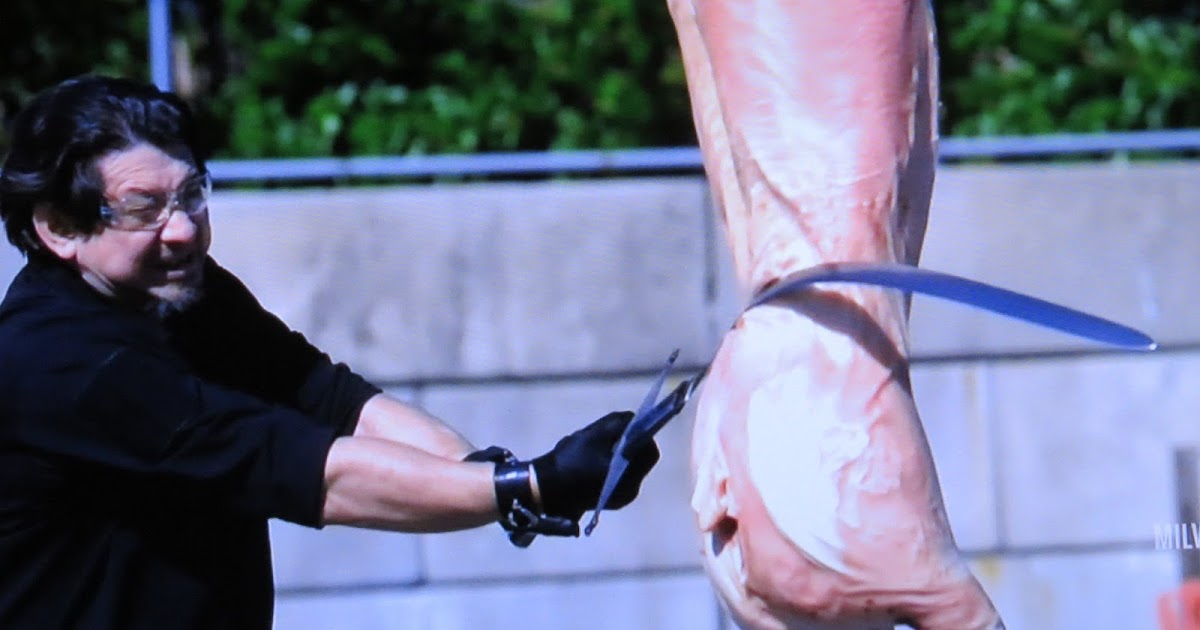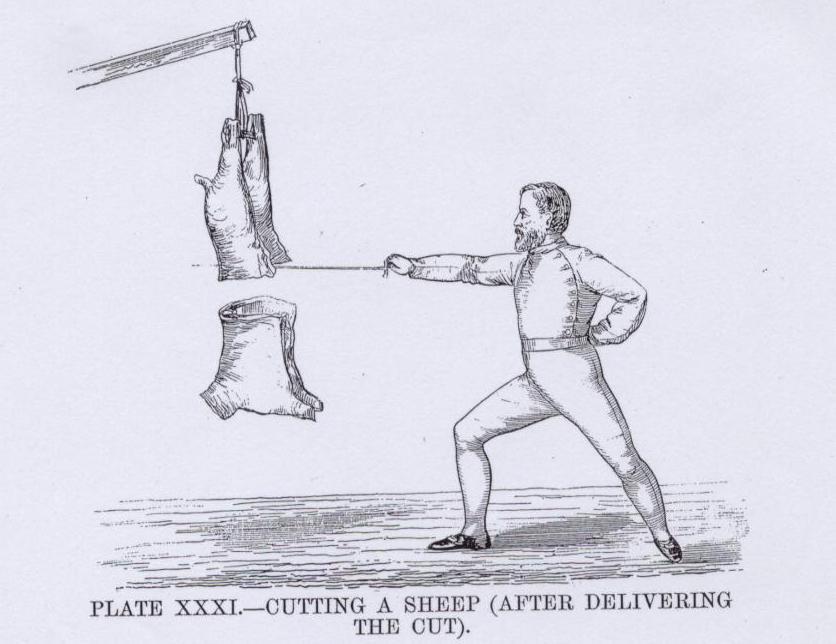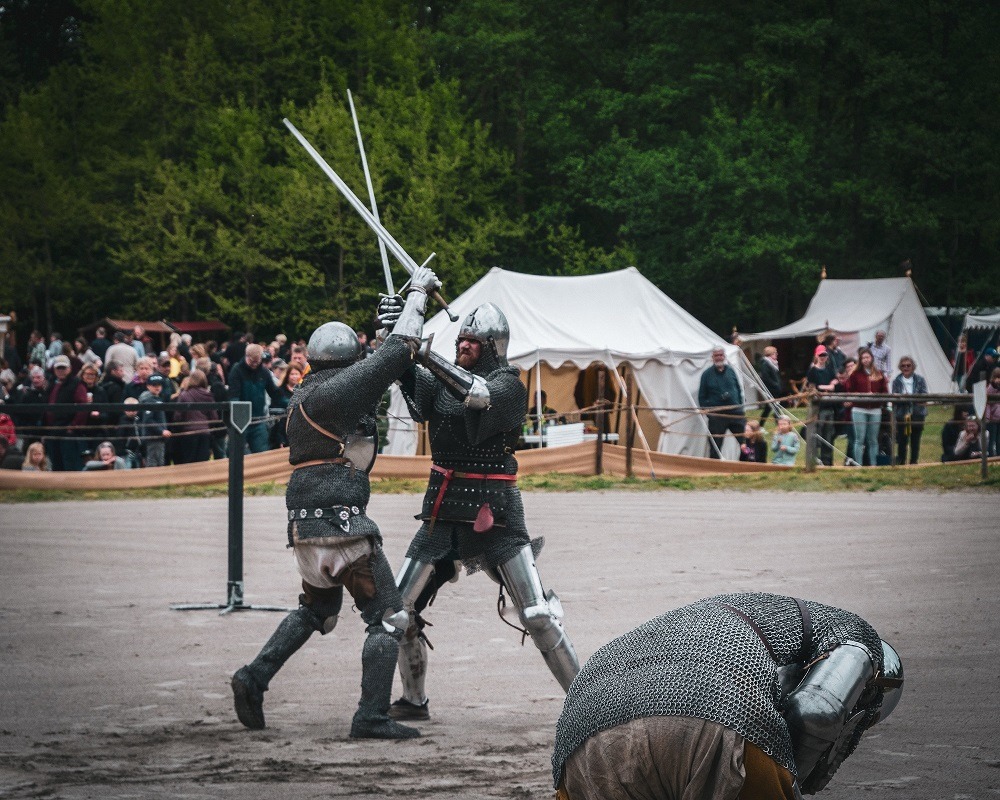The history and development of modern weight lifting is often obscured by the over-zealousness of certain fitness equipment companies to develop exciting marketing materials for their products. It is therefore not unusual for many fitness hobbyists and self-styled sports coach gurus to parrot mistaken ideas about the history of modern weight lifting, as the misinformation has managed to spread among several generations of athletes who all were exposed to the same marketing campaigns. These stories get shared and repeated, until the truth becomes difficult to locate.
While modern weight lifting is not strictly a historical practice among sword fighters, weighted resistance training is of great benefit to modern day sword fencers within the historical European martial arts community. So it may be of interest to many HEMAist to learn about the origins of modern weight lifting exercises. This article will briefly attempt to clear up some of the common misunderstandings about the origins and provide greater insight into the timeline of how modern weight lifting developed into its present day form.
The Origin of Modern Weight Lifting Exercises
When searching for the origins of modern weight lifting, you will find that many clickbait articles exist on the internet that are eager to link modern weight lifting training with ancient practices, but the truth is the type of weight lifting exercises that the majority of people do at the gym these days have little relationship to the strength training practices of ancient peoples. They are modern inventions.
While lifting heavy objects as a community challenge is an ancient practice, the specific types of exercises done at your local Planet Fitness or Gold’s Gym (or nearly every weight lifting gym in the world) are relatively recent inventions dating to the 1940s – 1970s.
Many fitness historians seeking to connect modern day fitness practices to ancient ones in order to weave an exciting tale are quick to point out humans have been using heavy stones as resistance training for centuries, but lifting and throwing stones isn’t the same thing as putting a barbell on your back with twice your own body weight on it. So trying to compare ancient fitness practices which bear no resemblance to modern weight lifting can create a very inaccurate perception about precisely how long humans have actually been doing what we regard as ‘weight lifting‘ today.
The truth is, if you could get the kind of muscular hypertrophy seen by contestants in modern body building contests from lifting and throwing rocks, then people wouldn’t have invented weight lifting equipment; they’d just get a bunch of rocks to throw around all day. No, the reason that such large muscular physiques are possible today is a result of more advanced weight lifting exercises having developed during the mid–20th century, and which were pioneered by athletes within the body building community.
You should not confuse people using things like weighted Indian clubs with people lifting 300 pound plates on a barbell using a squat rack. The latter didn’t exist before the 20th century. The barbell used for modern weight lifting was not invented until the last decades of the 19th century. Likewise, exercises popular currently such as the dead lifts, squat and bench presses did not exist until the 20th century.
Let’s also clear up a very common misconception.
Eugene Sandow did not invent body building
While Prussian strong man Eugene Sandow is often credited as the ‘father of body building‘, the reality is that the type of exercise that Eugene Sandow and his contemporaries practiced in the late 19th century had no relationship to the kinds of exercises that the majority of weight lifters today actually do. Instead the strong men like Sandow engaged in exercises — primarily sports — that were part of the physical culture community of his time period, such as the gymnastics systems developed by Pehr Henrik Ling and Friedrich Ludwig Jahn. In particular, Pehr Henrik Ling perhaps had the most impact on the recipe for structuring activities within physical culture, as he popularized exercises that became ubiquitous throughout many sub-practices within the physical culture movement; to the point that, through Sandow’s influence during his eight-month 1904–1905 tour of India where he performed and sold exercise instructional materials, he deeply influenced the direction of Indian fitness (which resulted in the modern version of yoga practices we see today — modern yoga uses many exercises popularized by individuals such as Sandow but developed originally by Ling. Britain at that time had colonized India, and its gymnastic and physical culture workouts were integrated into a form of “yoga” that is now what most people today know as yoga).
While it is true that Eugene Sandow was the driving force behind the ‘Great Competition’ event held on September 14, 1901, this event is commonly claimed to be the “first body building show” when it actually was not strictly such a thing. The event which Sandow helped organize was actually a multi-sport event featuring many different competitions, ranging from displays of fencing to wrestling. While the several day festivities concluded with a contest to determine which male participants had the most muscular physiques, that was not the only contest of the event.
So, the event Sandow held was a physical culture exhibition showcasing many different sports and practices. And this is what the winners of the physique judging looked like.
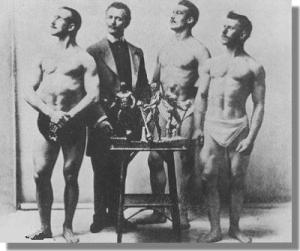
These are men who have the developed bodies of gymnasts. They do not possess the kind of muscular development you would see from years of modern weight lifting exercises, even without steroid usage.
We know that these pioneer strongmen were not practicing the kinds of weight lifting exercises that are popular today, because many of these strong men published their workouts as books. For example, William Bankier published ‘Ideal Physical Culture‘ in 1900 where he described exercises such as standing upright on a boat while oaring to help develop the muscles of the torso and pushing loaded hand carts up a hill. These exercises are adapted from manual labor and these kinds of exercises bear no resemblance to the kind of training athletes today use that are far more specific in exercising the muscles of the body. Sandow himself wrote a number of booklets, all of which are available for reading as they are in the public domain.
As example with Sandow himself, in ‘Sandow on Physical Culture (1894)‘ he mentions in the back of the book some exercises that can be done with kettlebells and weighted bars, and he does show some exercises with barbells still done today such as a standing bicep curl with barbell — but most of the ‘exercises’ he shows are in the context of strong man routines for spectacles, focused on displaying feats of strength. Sandow also talks about a complex system of resistance springs he designed and which no modern athlete today uses.
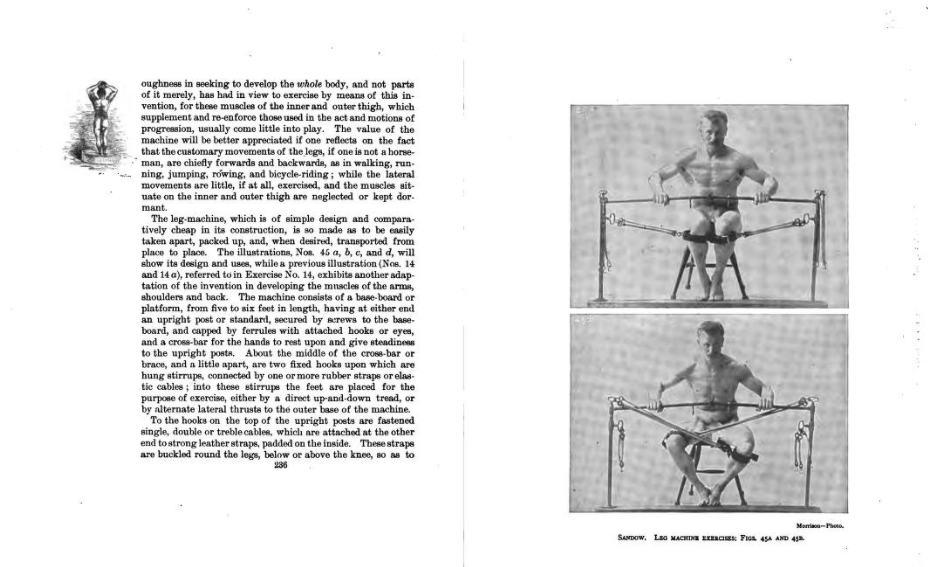
Later, in Strength and How to Obtain it (1897) Sandow shows his system of rubber cables that are somewhat similar to the kinds of exercise resistance bands used today, but these exercises are not used by modern body builders to develop the kinds of mass required for today’s competitions. They were not used back then to achieve such results, either.
Sandow’s book ‘Body-Building, Or Man in the Making‘ is sometimes claimed to show body building techniques, but it too does not describe modern body building weight resistance exercises. While the term ‘body building’ may have originated with Sandow, what Sandow actually describes in his book is a system of exercise much like what is found in all of his prior books, but with some added novelty inventions he desired to sell to the masses, such as his ‘spring-grip dumbbells‘, a rather silly exercise device that no one today uses — arguably, Sandow himself did not use it to develop his own physique, either. This is one of the reasons for why Sandow had a reputation as a charlatan among other strong men of his generation, viewing him as selling gimmicks and false information to the public.
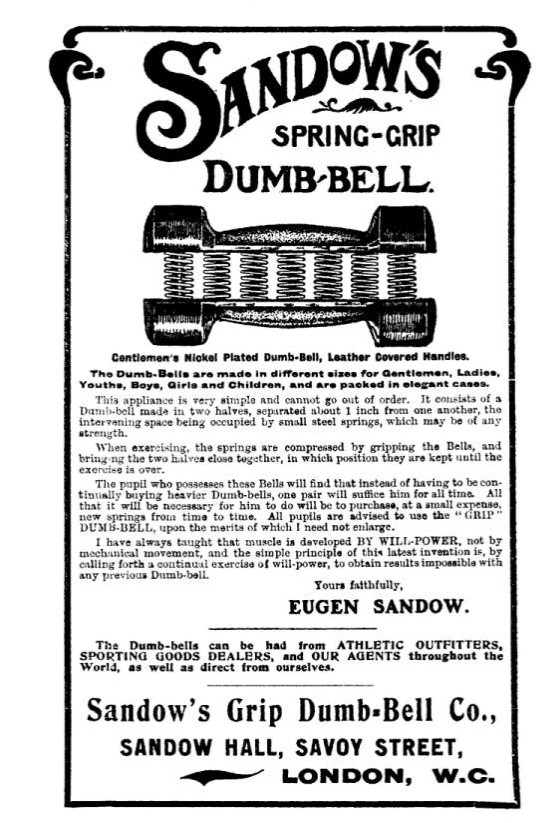
It is therefore erroneous to suggest that Sandow is the ‘father of modern body-building’ because he did not practice modern body-building, nor even modern weight lifting that is used by modern body builders. Sandow was a strong man and pioneering fitness guru who had great influence on spreading the popularity of physical culture, but he did not practice modern body-building nor use the types of exercises body-builders use today. His attribution as ‘father of body building’ is largely the consequence of the award named for him, as a piece of marketing for the Mr. Universe contest. This was seemingly done to make the sport of body building appear much older than it actually is to help better market it to the general public.
If Eugene Sandow was really the “father of” anything, he’d more accurately be called the ‘father of gimmicky useless fitness gizmos‘. The more negative aspects of the commercial fitness industry started with Eugene Sandow, which is one of the reasons he was disliked by many of his contemporary strong men.
In actuality, the strong men of the 19th century like Eugene Sandow built their muscular physiques primarily by working out with calisthenics and using equipment such as Olympic rings to do gymnastics. They did not develop their physiques primarily by lifting heavy objects repeatedly; they lifted their own body weight with gymnastics exercises, and did manual physical labor, such as moving heavy carts and chopping wood.
Again, there are many books on this topic, such as The Text Book of Weight-Lifting (1910) by Arthur Saxon, that depict a regime of kettlebell and barbell training for strong man acts; notably, the bent press for which Saxon was best known for.
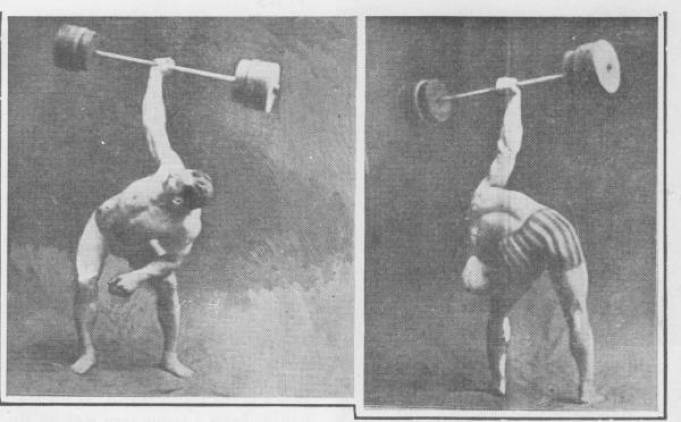
Yet as mentioned previously, the strong men of this era did not lift weights the same way that modern weight lifters do. Strong men were entertainers driven to do exciting lifts that would entertain crowds, even if it meant using tricks to cheat the weights. William Bankier, a strong man and contemporary critic of Eugene Sandow, said it best himself,
It is astonishing how ignorant people are now-a-days concerning feats of strength which, if they took the trouble to enquire into, would seem very simple after all. To read the announcements on the play-bills you would imagine that the Strong Man had the strength of half-a-dozen ordinary men. Whereas the real truth is that the strongest man known — if it could be decided who that is — has not more than the strength of two ordinary men in good health. That is to say, a strong man may lift a bar-bell weighing 240 lbs. (which is an extraordinary weight, and is about the heaviest that any strong man performs with) from the ground to arm’s-length above the head, with both hands ; and you can take two ordinary men and after a few minutes practice in getting them both to lift at the same moment, they will elevate the same weight. To lift a weight with two hands is considered the hardest way and the greatest test of a man’s strength. There are strong men who can raise with one hand from the shoulder to arm’s- length above the head, weights of from 200 to 230 lbs., but if you ask these same men to lift it with two hands it is ten-to- one they could not do it, proving that the one handed lift is accomplished with great practice, and is simply done with leverage of the body. This mode of lifting is not allowed in competition. It is always taken advantage of by Stage Athletes, as it is attractive, and sounds very well to say that the performer can raise such and such weight with one hand, the public thinking naturally that he could lift double the weight with two hands, the fact being that he probably could not lift it at all with both hands.
William Bankier, ‘Ideal Physical Culture‘ (1900), pg 29-30
The reality is that the weight lifting done by strong men entertainers were a spectacle during the 19th century, and they did not lift barbells and dumbbells for the same reasons that we do today, nor did they use the same exercises with this equipment that are routine in gyms today. The weight lifting exercises we use today were invented decades later.
This is important to understand for proper context when looking at some of the exercises these strong men describe in their books; Strong men like Sandow did not do exercises like the bent press to muscle exhaustion and they cheated the weights for their performances. And some of their books (such as those written by Sandow himself) do not describe exercise workouts they actually did to develop the physiques they were known for, as the books were written solely to commercialize their fame — often without regard to whether the workouts would help readers. If you look at their books without understanding the context of how they actually trained and performed and then try to apply modern training principles and habits to their exercises, you could seriously injure yourself. There are some modern kettlebell weight lifters who do strong man lifts like the bent press with great intensity to muscle failure; this is very dangerous and should not be done.
How the weight lifting exercises we use today came to be created
Modern weight lifting has its origins in the development of what was called halterofilia within the physical culture movement of the mid 19th century. The word comes from halteres, a kind of weighted stone used for exercising among the ancient Greeks — primarily held when performing long jumps and then thrown behind to gain more distance. The word halterofilia is still used today in Spain in reference to weight lifting, mostly as an ever-persistent misunderstanding of how halteres were actually used by ancient Greek athletes.
The physical culture movement also adapted some of the (arguably, unusual) gymnasium exercises that emerged during the European Renaissance period, which itself had been sparked from surviving ancient Greek and Roman accounts of athletics that were studied as part of the cultural movement of this time period.

Men using hand held weights for exercising, from the De Arte Gymnastica (Venice, 1569) by Girolamo Mercuriale.
While they bear a similarity in form, these hand-held weights were not used the same way that we use dumbbells today; the weights were held in the hand as the men took steps forward and twisted their torsos and struck poses. As shown in the above illustration, sometimes the resistance training even involved striking objects with the weights.
The only modern parallel to this would be low impact weight resistance cardio workout classes, where very low weight dumbells are used in conjunction with low-intensity calisthenics exercises such as jumping jacks and other step workouts.
It is worth noting that experimentations of using pully systems for resistance training were also done at this time in Europe, although they tended to be group workouts, seemingly in imitation of manual labor at construction sites (The kinds of weight resistance pully exercises used today to isolate hard to grow muscle groups, such as the triceps, are modern practices).
These practices developed during the Renaissance continued to be used by Europeans interested in physical conditioning up until the 19th century. As Europeans became introduced to some of the physical culture traditions of India through trade and eventually, conquest by the British Empire, many Europeans incorporated other Indian fitness practices, such as hatha yoga, and weighted clubs / scepters. The intermixing of physical cultures of West and East resulted in modifications of these practices so they could conform to the synchronized group drill workout format that had been popularized by gymnastics (this is also how modern yoga became focused on synchronized group workout classes).
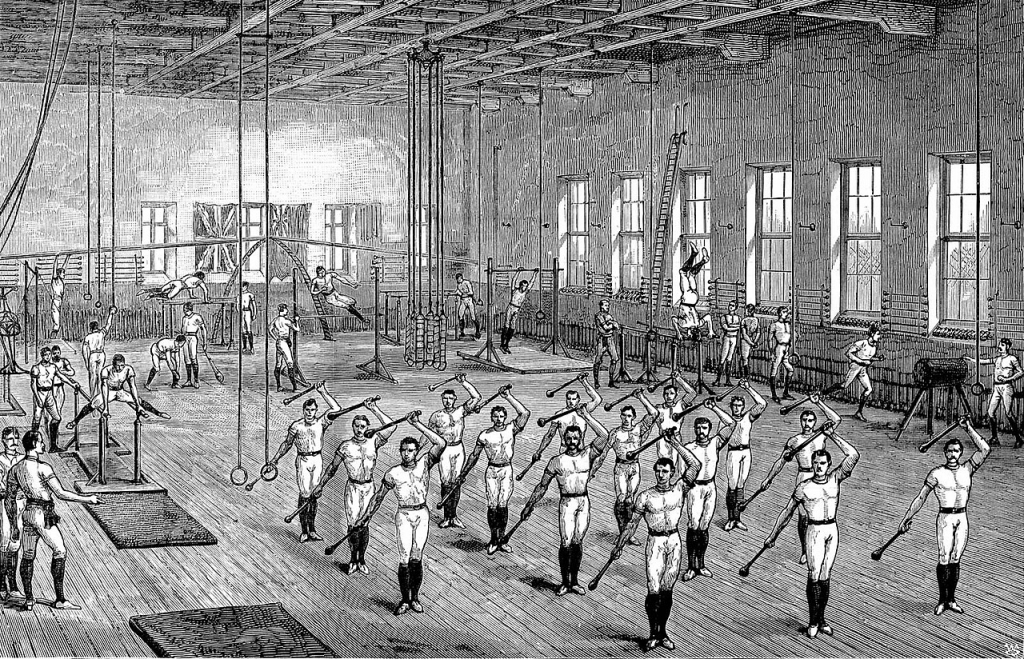
Wood engraving illustrating men engaged in athletics at a Young Men’s Christian Association (YMCA) gymnasium in Longacre, London circa 1888. The scene depicts a group Indian club class.
Hand held weights continued to be used for resistance training while walking and posing in the tradition of the Renaissance gymnasium up until the 19th century. They became more popularized during the Muscular Christianity fad which ultimately kicked off the wider, global physical culture movement that lasted for several decades through influence of organizations such as Young Men’s Christian Association (YMCA) and similar groups. As these hand held weights were meant to be used with full body motions they were not very heavy compared to the weight used today by modern weight lifters. While these hand held weights are a predecessor to the dumbell we use today, the exercises that were done with them only have modern parallels to the kind of low-impact weighted cardio workouts used by some women’s fitness classes today.
The shape of hand held weighted bars that originated in the Renaissance re-imagining of Greek physical culture continued to evolve into the form of dumbbells, produced of iron and in varying weights, which could be arranged in racks at a gym. We know these were in use by at least 1861, as related in an article titled ‘Gymnastics‘ by Thomas Wentworth Higginson printed in Atlantic Monthly. He wrote that a man could exercise every muscle in his body with a 50 pound dumbbell in two-hands, or while holding two half that size in each hand.
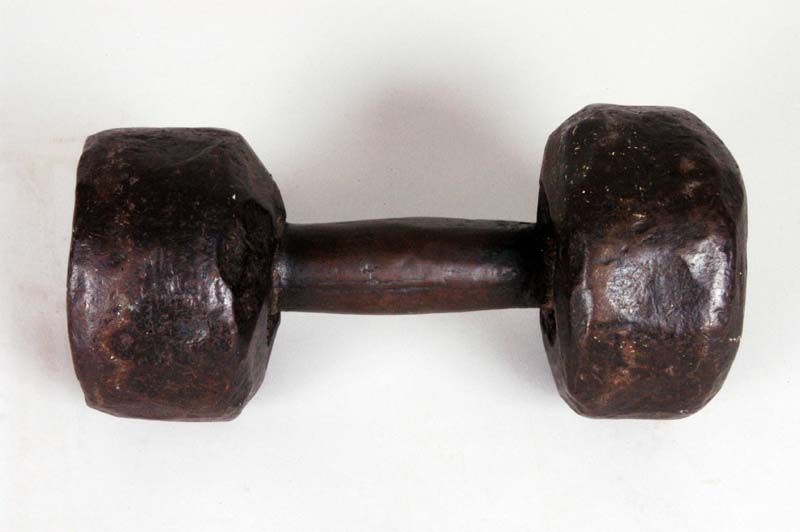
The first interchangeable weighted dumbbells and barbells had hollow globes that could be filled with sand or lead shot to increase their weight. While precise dates for their invention are difficult to locate, they are claimed to have been in use at least by 1854 according to Jan Todd in her essay, ‘From Milo to Milo: A History of Barbells, Dumbells and Indian Clubs‘. Spherical dumbbells and barbells are said to appear in several illustrations printed in the 1854 edition of ‘Les Rois de la Force‘ (The Kings of Strength) by Edmond Desbonnet. While I could not find any images of this edition, I was able to locate the 1911 edition.
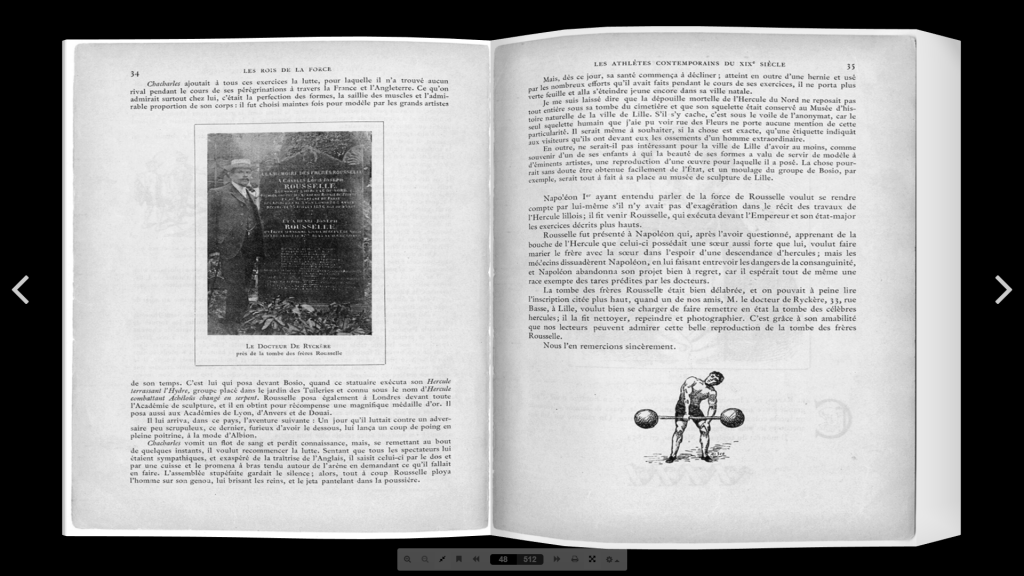
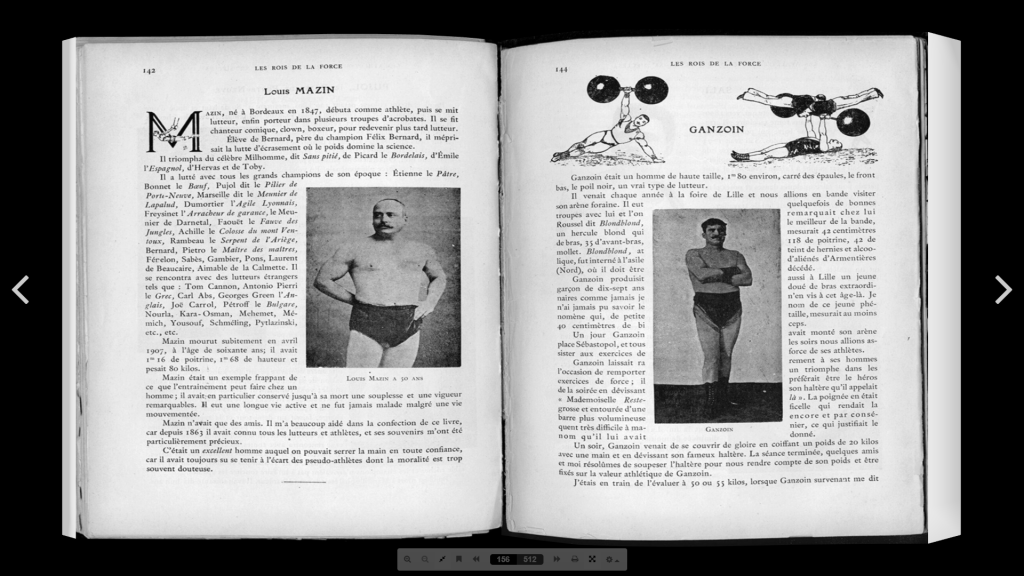
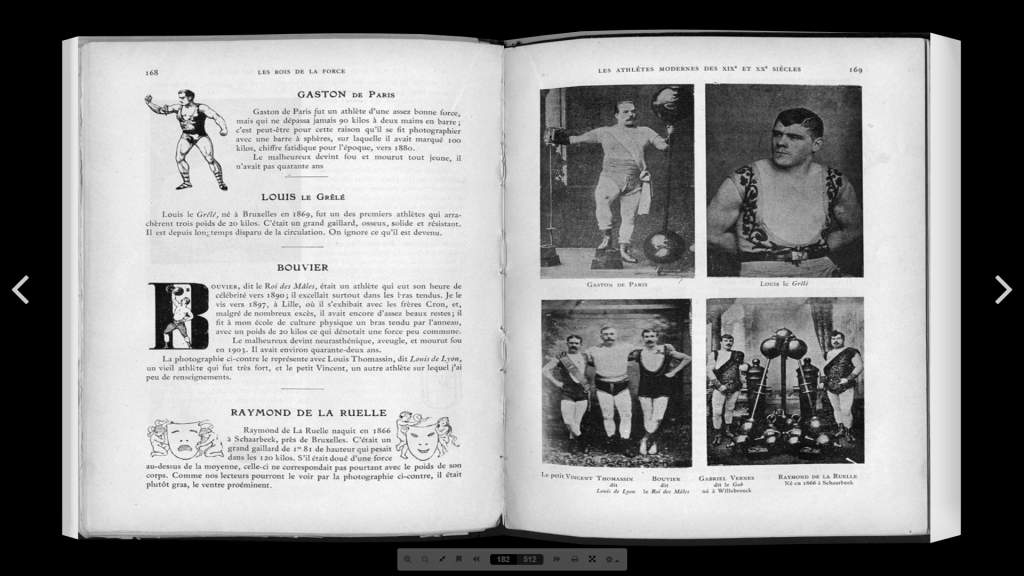
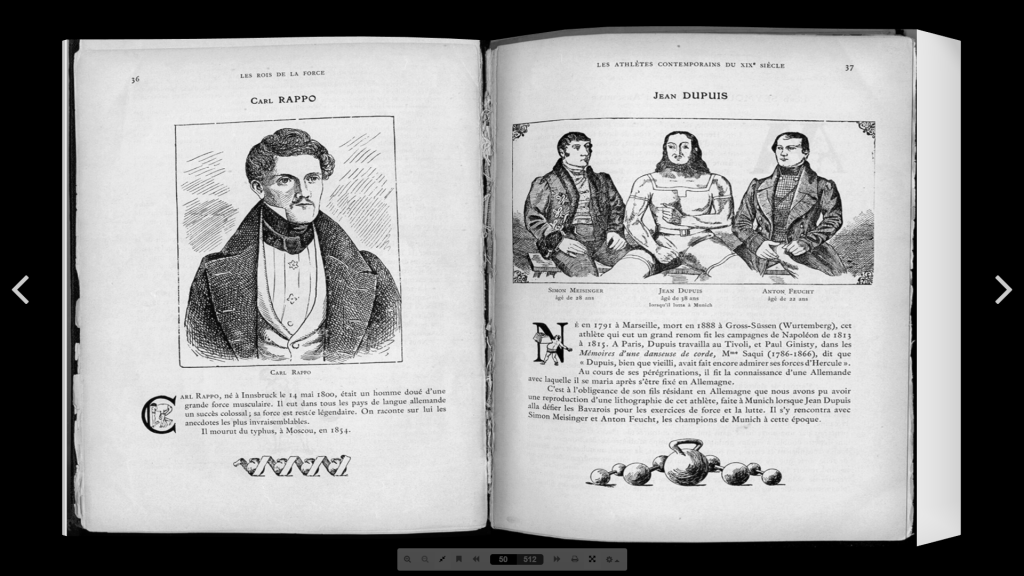
These spherical hollowed out barbell heads that were once popular have become replaced by the interchangeable plate barbell system used today; plate-like barbells were sometimes used, but rarely by strong-men. The spherical barbells styles were much more commonplace.
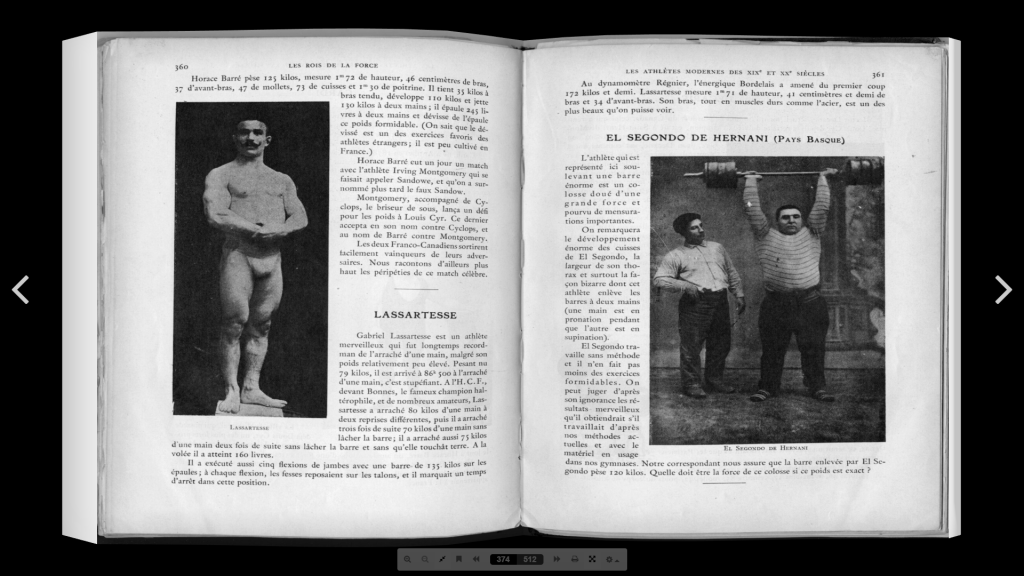
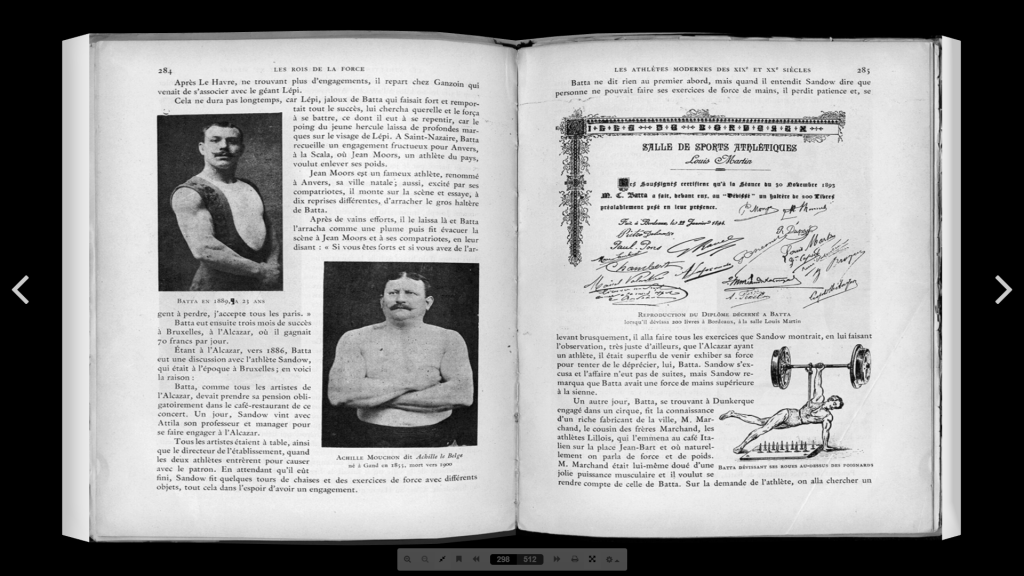
These barbells were used, as the photos and illustration show, primarily to demonstrate feats of strength for strongmen at carnivals; often lifted one-handed while the strong man laid side-ways or stood up-right. Many of these feats did require above average strength, but were achieved by using tricks to adjust body weight to help lift the object overhead. These were not the kinds of muscle isolation exercises practiced by weight lifters today; they were intended to help the strong man lift as much weight over his head by any means necessary, even if using shifting body weight for leverage and alignments of the skeletal frame for support. Most of these exercises would be considered ‘cheating’ today if someone were to do them in a gym.
The development of modern style dumbbells and barbells
The dumbbells and barbells used in the 19th century were custom made equipment, usually commissioned by a blacksmith or home-made by the strong man himself. However, toward the end of the 19th century efforts were made to produce commercially viable equipment to sell to the average man who aspired to become a strong man. George Barker Windship patented an invention in 1895 for using interchangeable weighted plates on a dumbbell; however it did not find commercial success. Most manufacturers primarily sold dumbbells from 25 to 50 pounds of weight, pre-constructed. Barbells were also not widely available for purchase through commercial shops and mail order catalogs (pg.9, ‘From Milo to Milo: A History of Barbells, Dumbells and Indian Clubs‘ by Jan Todd), especially after the 1930s once the physical culture fad had died down.
Having said this, the first company to obtain great nation-wide success distributing weight lifting dumbbells and barbells in the United States was the Milo Barbell Company formed in 1902 by Alan Calvert in Philadelphia, Pennsylvania. The Milo Barbell Company first sold the hollow, spherical kind of dumbell and barbells commonly used by strongmen, but later developed a plated system of dumbell, called the Milo Tripex. Several competitors would emerge, such as the York Barbell Company and the Jackson Barbell Company, who would further help popularize dumbbells and barbells.
The habit of strong men entertainers to challenge each other to difficult, exotic lifts eventually resulted in a standardized competitive sport of weight lifting emerging. Weight lifting was introduced as an Olympic event for the the 1896 Summer Olympics in Athens, Greece. The rules were very different than they are today. The event had a two-handed lift and a one-handed lift; the two-handed lift bearing some resemblance to a present day ‘clean and jerk’ lift and the one-handed lift resembling a barbell snatch. Both of these exercises were used as part of strong men routines, but now were incorporated as a measurement for competition between weight lifters. The style of barbell and dumbell used for the event was developed by Kaspar Berg, and was quickly copied by several barbell companies. They helped popularize these models, advertising them as ‘Olympic style’ barbells and dumbbells. By the 1940s dumbbell and barbells had largely replaced all other kinds of weight training devices among weight lifters, such as rubber bands, Indian clubs and kettlebells (girya) through a combination of the marketing efforts of these companies, and the world wide popularity of the Olympic Games. Most weight lifters in the early 20th century were focused on Olympic style weight lifting; it is reasonable to suspect that had kettlebells and Indian clubs also became Olympic events, we might have seen a different outcome in regards to their continual popularity.
Kettlebells had been popularized by Vladislav Kraevsky as a form of exercise, and they became adopted by Russian strong men who spread the devices around as they toured the world.
Kettlebells would retain some popularity in the Eastern European countries, though not as much as many present day kettlebell manufacturers seeking to market the equipment often claim. The lasting popularity was restricted among competitive kettlebell lifting clubs that organized in the 1940s. As with most of the world at this time, Olympic style weight lifting was the most popular among Russians, for the same reasons that it became popular elsewhere. It seems that only over the past few decades, as renewed interest in physical culture of the late 19th century has become a fad, that kettlebells and Indian clubs have gained widespread renewed interest in the West.
(As a note, it is often claimed that in 1981 the Russian government implemented mandatory kettlebell training for all of its citizens, but I can find no credible source to confirm this claim.
If you’d like more information on the subject of the development of dumbbells and barbells in the physical culture movement, it is suggested you read the essay, ‘From Milo to Milo: A History of Barbells, Dumbells and Indian Clubs‘ by Jan Todd.)
While barbells and dumbbells were solidifying their shape and form, the way they were used was still not comparable to modern day weight lifting exercises. Athletes often used questionable, sometimes dangerous exercises. For example, instead of the kind of squat used today, weight lifters would practice things like the deep knee bend. This was basically a Hindu squat with a barbell. Such an exercise places a dangerous amount of force on the joints, instead of working the muscles.
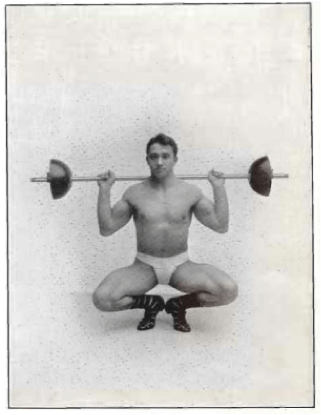
The deep knee bend as demonstrated in a photo from “Bodybuilding and Muscle Developing Exercises”, a pamphlet produced by by the Milo Bar-Bell Company in 1915
One notable aspect of the weight training done at this time is the small amount of weight that was used to do repetitions. The instructional booklets produced by the Milo company suggested doing what they called ‘double progression’ — one set of 20 reps per exercise increasing 2 reps every third workout until 40 rep sets were reached, then add 10lbs and start again at 20 reps. This is how weights were used for daily training for several decades by most of the men who did weight lifting in the early 20th century.
The emergence of modern weight lifting: 1940s to the 1970s
Even up to the 1940s, while the shape and form of dumbbells and barbells became standardized, the weight training exercises used by weight lifters were still very experimental, as the science of exercising was not as well understood as it is today. Here is a video showcasing some of the useless weight lifting exercises that were popular during the 1940s and are no longer used today,
However, some of the groundwork for modern weight lifting exercises was being laid. The first modern form squat seems to have been developed by at least 1921. Heinrich “Henry” Steinborn was photographed in Strength magazine performing a movement that resembles a modern day squat, although he does not have a squat rack.
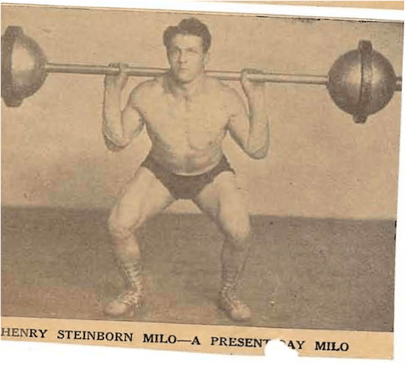
This is because the squat rack was invented in the 1960s by Terry Todd and Craig Whitehead as part of experiments on weight lifting, the goal of reaching “maximum fatigue” and yet still able to set the weights down safely. The squat rack invention was then popularized in the Iron Man magazine article, “Power Rack Training for Maximum Muscular Development” by Peary Radar, appearing in vol. 23, no. 6 (1964), pp. 22–27, 46.
This meant that although Steinborn is seen performing a squat in 1921, because he must lift the weight up above his head to get it onto his shoulders and then be able to safely let it back down, it greatly limits how much weight he can squat since he does not have the benefit of a squat rack to assist him with getting heavier weights onto his shoulders and taking them off his shoulders. Were he to work his muscles to total failure he could injure himself as he cannot safely release the weight from his shoulders.
(Some knowledgeable readers may know that the Smith machine — which is a machine assisted squat exercise device — was invented in the 1950s by Jack Lalanne. I would however argue they were not widely available in the 1950s, and also that using a Smith machine does not allow for full range of motion of the leg muscles and is unnatural, so it doesn’t provide a sufficient workout. Serious weight lifters do not use Smith machines when squatting unless they don’t have a spotter.)
So while we sometimes see predecessor exercises before the 1950s, the truth is that most of the exercises used today in weight lifting gyms were developed within the body building community during the 50s, 60s and 70s. The specific modern sport discipline of body building has its origin in the founding of the International Federation of Bodybuilding and Fitness (IFBB) in 1946 by brothers Ben and Joe Weider. Originally started as an extension of their fitness magazine Your Physique (presently called Muscle & Fitness) ; the magazine itself was a promotional vehicle for their nutritional supplement company, Weider Nutrition), IFBB catered to weight lifters in Canada and the United States. IFBB was intended to be an alternative to the Amateur Athletic Union (AAU), which operated the Mr. America contests for ‘America’s fittest men’, (in addition to having a near monopoly on all sports events in the USA through a relationship with the Olympics). Yet, the IFBB organization’s membership was able to expand globally throughout the 1950s due to the brothers’ publicity efforts. The lifestyle and exercises of the body building weight lifters were also popularized through magazines such as Iron Man Magazine (started publication in 1936) and Muscular Development (began publication in 1964). Some of the writers for these two publications also wrote articles for Sports Illustrated (began publication in 1954) which too helped introduce weight lifting exercises to general sports enthusiasts.
Of these publications Muscular Development in particular had the most early influence on the development of modern body building exercises popular today. The publication was started by Bob Hoffman to cater to a different demographic of weight lifters than his previous publication, Strength and Health, which had focused on Olympic weightlifting. However, during the 1950s the Olympic weight lifting sport became standardized around three events; Clean and Press, Snatch and Clean and Jerk. Other types of weight lifting exercises were banned from pro competitions to be used as qualifiers. This change was not widely popular, resulting in a splintering of the community. This gave way to the sport of power lifting, but it also got more people interested in what the body builders were doing as they sought new organizations like IFBB to join. Hoffman, who also owned the York Barbell Company, sought to take advantage of this splintering of the competitive weight lifting community, so Muscular Development prioritized coverage of events in both the emerging body building and power lifting communities. As these became world wide sports, his publication gained world wide distribution and influence.
As for the early body building shows of this early era, such as the Mr. America show organized by the Amateur Athletic Union, they were more of a male beauty contest than a modern body building show. Most of the contestants were not specifically training to increase their muscle sizes, but rather developed their physiques through other sport activities. During this time period the most popular “body building” (that is, muscle size growing as a goal) course was a mail order curriculum of books written by Earle E. Liederman. A former student of Eugene Sandow, Earle E. Liederman’s course emphasized body weight calisthenics and an elastic chest expander, a device also ordered as part of his course. This course could also be done in addition to some supplementary weight training, which at this point in history was often fixated around the style of Olympic weight lifting at the time but also could incorporate what would later be called power lifting, since competitions of this era were loosely organized by local federations that served as qualifiers for the Olympics.
It is also worth mentioning that, in addition to the growing number of national weight lifting federations worldwide due to the inclusion of weight lifting as an event in the Olympics, the celebrity status of many film stars who practiced weight lifting (such as Reg Park, Stephen Lester Reeves, and Johnny Weissmuller) also helped popularize the practice world-wide, too; as did the development of the first genuine body building contests for body building weight lifters, such as Mr. Universe (1948) and Mr. Olympia (1965). While the Mr.America contests had been running since 1939, contestants had primarily been members of the Amateur Athletic Union (AAU) and developed their physiques through other sports. An example of these men is John Grimek, who in addition to winning several body building contests in the early 1940s, was also a competitive Olympic weight lifter (he represented the USA in the 1936 Olympic Games), as well as a gymnast.
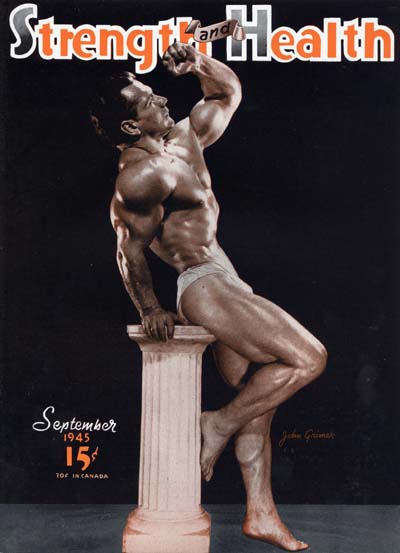
The physique of John Grimek on the cover of the September 1945 Strength & Health Magazine issue.
Grimek is notable because he stands at a meeting ground between body building specific weight lifting, competition weight lifting and strong man showman weight lifting (he did some of this as a performance, such as iron bar bending); the place in weight lifting history where it all started to become more niche. By the end of his career Grimek was doing more varied weight lifting exercises, 3 sets of 10 reps with the weight training he did, but still also used body weight calisthenics such as dips and pullups. Specifically, his training program used compound multi-joint exercises and a small number of isolation exercises,
John Grimek’s Weight Lifting Workout (1950s)
Monday
Bench Press: 3 sets of 10 reps
Chin ups / Pulls downs: 3 sets of 10 reps
Military press: 3 sets of 10 reps
Barbell curl: 3 sets of 10 reps
Squats: 3 sets of 10 reps
Wednesday
Incline Press or Dips: 3 sets of 10 reps
Barbell Row / Dumbell Row: 3 sets of 10 reps
Shrugs: 3 sets of 10 reps
Single Arm Preacher Curl: 3 sets of 10 reps
Leg curl: 3 sets of 10 reps
Abs (situps): 1 set, 10 reps
Friday
Chin ups / pull downs: 3 sets of 10 reps
Military press: 3 sets of 10 reps
Incline dumbell curls: 3 sets of 10 reps
Front squats: 3 sets of 10 reps
Stiff legged deadlift: 3 sets of 10 reps
Before the splinter in the 1950s, at this time most all weight lifters primarily used the Olympic weight lifting exercises to build their physiques, with some experimentation in other kinds of exercises depending on their goals. Yet the splinter motivated many to abandon Olympic style lifting to experiment more. It is from these non-Olympic weight lifting meets and events that exercises such as the bench press, squat, and deadlift truly developed into the forms practiced today by the majority of weight lifters, in addition to other kinds of concentration exercises, such as the concentrated bicep curl, shoulder presses and so on. Through national federations of weight lifters that had been organized for Olympic competition but now broke away, information became shared to weight lifters around the world through printed newsletters and magazines that educated them about these new kinds of weight lifting techniques.
Yet, while the sports of Olympic weightlifting and power lifting focused on mastery over a handful of full body motion weight lifting exercises, body builders desired to stimulate muscle growth to gain size. This desire resulted in body builders to focus on trying to obtain complete muscle fatigue using progressively heavier and heavier free weights, with exercises designed to isolate different muscle groups. This is in comparison to the full body resistance training and more complex full body strength moves used by the strong men, which both Olympic weight lifting and power lifting have carried on with their sport focused on heavier and heavier lifts of a handful of exercises designed to test total body strength.
Body builders consequently developed many different kinds of exercises to concentrate load in specific muscle groups to challenge and exhaust them. This training, combined with protein heavy diets (and anabolic steroid usage) resulted in weight lifters within the body building community to grow faster and larger muscles than had been seen in prior generations of weight lifters. This developed body building into a unique sport separate from both Olympic weight lifting and power lifting, which produced different results in the physiques so developed by the athletes.
High intensity training (HIT) exercise machines were developed in the 1970s by Arthur Jones. Jones invented a line of exercise machines produced through his company Nautilus, Inc. that allowed a weight lifter to quickly reach muscle failure without needing to do many sets of repetitions using free weights, as had been necessary for body builders to use. This allowed muscle failure to be reached in considerably less time. These exercise machines were marketed in body building magazines such as Iron Man, and became popular at gyms and even at sold commercially to individuals for home usage. Today these kinds of machines are the most popular kind of weight lifting done by athletes today.
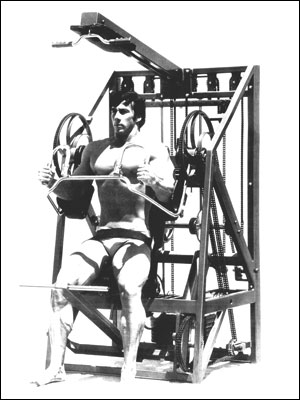
An example of an early Nautilus exercise machine that made High intensity training (HIT) more accessible to the average person.
Modern weight training exercises become mainstream
The single most important event that caused body building weight training exercises to surpass the popularity of Olympic style weight training was the release of the film Pumping Iron in 1977. Documenting the lives of the top competitors of the 1975 IFBB Mr. Universe and Mr. Olympia competitions, it shined a spotlight on the style of weight resistance training that had developed separately from both the Olympic and power lifting sport communities, and which was focused on bulking up the size of the athletes muscle groups to perform in these body building contests. The film is largely responsible for the fitness craze of the 1980s which resulted in the demand for weight training gyms becoming popular enough that such gyms could be found in most all shopping malls during the 80s and 90s; previously they were rare even within major cities.
After the release of the Pumping Iron documentary film, the workouts which had been featured in the Iron Man magazine were organized by one of its writers, Anthony Ditillo, in the book, ‘The Development of Physical Strength’ (1982), and advertised to its newfound mass of readers who had subscribed to learn more about body building as a result of Pumping Iron‘s popularity. This further helped popularize exercises such as the bench press, squat and dead lift. However, the 1985 publication of The Encyclopedia of Modern Bodybuilding by Arnold Schwarzenegger was far more influential. Released as a series of five books, this work provided detailed lists of exercises which had been developed by body builders over the past few decades, as well as nutritional advice. It also included tips for posing and attending contests. Leveraging the star power of Arnold Schwarzenegger it became the most popular body building instructional book for many decades, with revisions and re-publications.
This is how the weight training exercises most people use at gyms today developed and became popularized.
****
We hope you enjoyed this brief lesson about the history of modern weight lifting.
If you’d like to learn more information about historical fencing practices please check out our Learn HEMA page for a guide to learning about the historical weapon that interests you. You can also find more guides we’ve written about other topics at our Helpful Guides page. Feel free to share your thoughts on this article by commenting or at our forums or our Facebook Group.
Related posts:
- Which Martial Arts Use Swords? A List of Martial Arts to Learn Sword Fighting
- How to Learn Dual Wielding Two Sword Fighting Techniques in HEMA
- German Long Sword Fighting Techniques in HEMA
- Why the History Channel TV Series Forged In Fire Is a Bad Representative of Historical Swordsmanship and Blade Forging
